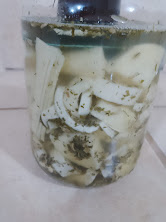I have otherwise posted about preparing fermented vegetables, specifically sauerkraut, often along with other vegetables. Since that post is very comprehensive, I will make this one brief. While that other post is based on the dry method (ie fermenting without added water by expelling water that is naturally occurring within a vegetable like cabbage), this post discusses the alternative, ie the 'wet method' because it involves adding water. This is an alternative to sauerkraut if you do not have vegetables like cabbage that can produce enough water to entirely submerge the vegetables.
Unlike sauerkraut, this process does not involve bruising or massaging the vegetables. All you need to do is pack the vegetables and add enough brine to submerge them. Everything else that applies to sauerkraut applies.
All that extra brine
I enjoy using the extra brine for other ferments, as a starter for sauerkraut and subsequent vegetable ferments. Otherwise, I use the brine along with the vegetables along with other foods like blandly boiled pearl barley along with any delicious extras like nutritional yeast.
You will need
- raw vegetables. Crudely cut. I prefer crude cuts so as to prevent tiny pieces from floating above the brine. As much as possible, keep the skins, even for garlic. Here are some examples of commonly used vegetables. If you have organic vegetables, wash rather than discard the skin. You can wash and scrub them with diluted vinegar or lemon juice without killing all of the good bacteria. However, washing them this way, along with scrubbing them with a brush or even baking soda and or salt will remove wax coating. Never use antibacterial soaps because they will kill good bacteria. Many nutrients and good bacteria are abundant in the skin. While it is common to ferment only 1 vegetable at a time, you can get as colorful and varied as you like. Since this is not a science, just use what you have. See some variations below.
- vegetables: carrots, sweet peppers, mushrooms, broccoli, cucumbers, sweet potato
- herbs & spices: garlic, onions, basil leaves, thyme leaves. BTW, the intense flavor of garlic and onion become so much less intense that you can add more than just a pinch if you are particularly interested in them.
- herbs, flavorful (garlic, dill, onion, peppers). You can use dried herbs also.
- brine. Make enough to completely submerge the vegetables.
- salt, 3% of water (ie apx 1 tbsp salt to 2 cups of water)
- non-chlorinated water
- optional. 1 Black tea tea bag for tannin per jar (or 2 tea bags of Green tea bag). Other alternatives include grape vine leaves. Tannin may keep vegetables crispier than otherwise. Place the bag at the base of your fermentation jar ... or use brewed tea as the base for your brine.
- weight or disk (to keep the vegetables below the level of the brine)
Here are some other delicious mixes that I have made.
Heart of palm (below). The taste and texture, even before fermentation, are great. However, I am on the fence about using this ingredient from a conservation perspective.
CONTENT RELATED TO FERMENTED VEGETABLES
- Speedup digestion
- Fermented foods
- Sauerkraut (full instructions)
- Fermented vegetables
- Vegan ceviche
- Fermented garlic in honey
- Ginger bug
- Fermented drinks (ginger ale, fermented lemonade, etc)
- Cheong: sweet fermented syrup
- High protein yogurt with chickpeas
- Extra creamy yogurt with oats
- DIY chickpea yogurt
- Oat yogurt
- Vegan milks and other drinks
- Tofu
- Breakfast or snacks
- Vegan Caribbean Christmas cake
- Pink (beetroot) pancake recipe
- Tortillas (Green spinach)
- Protein granola bar
- Pizza
- Barbadian (aka Bajan) conkies
- Other
- Vegan eggs
- Topping (guacamole inspired)
- Papaya salad to improve enzyme activity and improve digestive health
- Sprouts (lentils)
- Ghee (not vegan)
- Agar agar (medicinal superfood great for making vegan flan with vegan milks)






